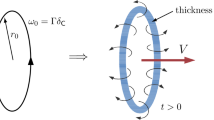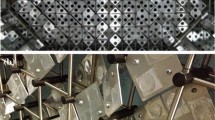Summary
Consideration of the physical explanation of the existence of an isopycnic level at 8 km permitted the existence of another isopycnic level at about 24 km to be foreseen. Further evidence suggesting the reality of this second isopycnic level is given. The study of the dynamical implications of the existence of the isopycnic level at 8 km led to the discovery of the existence of a level of horizontal flow of air nearby. This was found to exist at about 9 km. A further study showed the probable existence of another level of horizontal flow at about 17 km. The integration of the linearized Eulerian equations of atmospheric motion shows that for the periods and wavelengths observed in the large scale motion of the atmosphere the solution is cellular, with nodal surfaces for all independent variables.
If the numerical value of the constant of integration in the equations giving the heights of the nodal surfaces is determined by means of the empirical value of the height of one such surface, the heights of all the other theoretical nodal surfaces can be computed. The numerical agreement between the experimental and theoretical results is rather satisfactory. The cell motion which is deduced to exist in the atmosphere explains a number of other features of atmospheric dynamics, such as the distribution of divergence and vertical motion. The frequency of mother-of-pearl clouds found byHesstvedt fits fairly well in the scheme; this scheme may also provide a physical explanation of other nodal surfaces found at higher levels, such as the level of horizontal motion at about 50–60 km and the isopycnic level at about 80 km, as well as the frequency of the noctilucent clouds.
Zusammenfassung
Die Untersuchung der physikalischen Erklärung einer isopyknischen Schicht in 8 km Höhe gestattete, die Existenz eines anderen isopyknischen Niveaus in ungefähr 24 km Höhe vorauszusagen. Es werden weitere Beweise für die Realität dieses zweiten isopyknischen Niveaus gegeben. Die Untersuchung der dynamischen Folgerungen aus der Existenz der isopyknischen Schicht in 8 km führte zur Entdeckung der Existenz eines Niveaus mit horizontaler Luftströmung in 9 km Höhe. Eine weitere Prüfung ergab die wahrscheinliche Existenz eines anderen Niveaus mit horizontaler Luftströmung in ungefähr 17 km. Die Integration der linearisierten Eulerschen Gleichungen der Luftbewegung zeigt, daß die Lösung für die Perioden und Wellenlängen, welche in der großräumigen Bewegung der Atmosphäre beobachtet werden, zellenförmig ist und Knotenflächen für alle unabhängigen Veränderlichen aufweist.
Wenn der numerische Wert der Integrationskonstanten in den Gleichungen, die die Höhen der Knotenflächen geben, mittels des empirischen Wertes der Höhe einer dieser Flächen bestimmt wird, so können die Höhen aller anderen theoretischen Knotenflächen berechnet werden. Die numerische Übereinstimmung zwischen den experimentellen und theoretischen Resultaten ist ziemlich zufriedenstellend. Die Zellenbewegung, deren Existenz in der Atmosphäre abgeleitet wurde, erklärt eine Reihe anderer Merkmale der Dynamik der Atmosphäre, wie z. B. die Verteilung der Divergenz und der Vertikalbewegung. Die Häufigkeit der Perlmutterwolken, welcheHesstvedt gefunden hat, fügt sich ziemlich gut in das Schema ein, welches auch eine physikalische Erklärung für andere Knotenflächen in höheren Niveaus liefern könnte, wie z. B. im Niveau horizontaler Bewegung in ungefähr 50 bis 60 km und das isopyknische Niveau bei ungefähr 80 km; die Frequenz der leuchtenden Nachtwolken dürfte sich mit diesem Schema ebenfalls erklären lassen.
Résumé
En considérant l'explication physique de l'existence d'un niveau isopycnique à 8 km, on peut prévoir l'existence d'un autre niveau isopycnique à environ 24 km. On indique également d'autres preuves de la réalité de ce second niveau isopycnique. L'étude dynamique de l'existence du niveau isopycnique à 8 km a mené à la découverte de l'existence d'un niveau d'écoulement horizontal de l'air à environ 9 km. Une étude additionnelle a montré l'existence probable d'un autre niveau à courant horizontal à environ 17 km. L'intégration des équations linéaires d'Euler pour les mouvements atmosphériques montre que pour les périodes et les longueurs d'ondes observées dans les dits mouvements la solution est cellulaire à grande échelle, avec des surfaces nodales pour toutes les variables indépendantes.
Si la valeur numérique de la constante d'intégration dans les équations qui donnent les hauteurs des surfaces nodales est déterminée par la valeur empirique de la hauteur d'une de ces surfaces, on peut calculer les hauteurs de toutes les autres surfaces nodales théoriques. L'accord numérique entre les résultats expérimentaux et théoriques est assez bon. Le mouvement cellulaire dont on déduit l'existence dans l'atmosphère explique plusieurs autres particularités de la dynamique de l'atmosphère, par exemple la distribution de divergences et de mouvements verticaux. La fréquence de nuages nacrés queHesstvedt a trouvée prend assez bien place dans le schéma qui peut aussi fournir une explication physique pour d'autres surfaces nodales qu'on trouve à des niveaux plus élevés, par exemple le niveau de mouvement horizontal situé à environ 50–60 km et le niveau isopycnique à environ 80 km. La fréquence des nuages lumineux nocturnes pourrait aussi bien être expliquée au moyen de ce schéma.
Similar content being viewed by others
References
Alfuth, W. H.: Some Features of Air Density Profiles up to the Middle Stratosphere. Research Laboratory, Report No. RR-TR-61-4, Res. and Develop. Directorate U. S. Army Ordnance Missiles Command (1961).
Bjerknes, V., J. Bjerknes, M. Solberg, andT. Bergeron: Hydrodynamique Physique. Paris, 1934.
Cole, A. E.: Suggestion of a Second Isopycnic Level at 80 to 90 Kilometres over Churchill, Canada. J. Geophys. Res.66, 2773 (1961).
Cole, A. E., andA. Court: Density Distribution, Interlevel Correlations and Variation with Wind. Air Force Surveys in Geophysics No. 151, Air Force Cambridge Res. Lab., 1962.
Dines, W. H.: The Characteristics of the Free Atmosphere. Geophys. Mem. No. 13, p. 47. London, 1919.
Doporto, M.: The Computation of Atmospheric Pressure a the 8 km Level of Constant Air Density. Irish Met. Serv. Techn. Note No. 1 (Geophys. Publ.3, No. 4) (1943).
Doporto, M.: Dynamical Aspects of the Constancy of Air Density at 8 km. Irish Met. Serv. Techn. Note No. 2 (Geophys. Publ.3, No. 6) (1943).
Doporto, M.: Cell Motion in the Atmosphere. Irish Met. Serv. Techn. Note No. 6 (Geophys. Publ.3, No. 7) (1944).
Doporto, M.: The Isopycnic Level and the Coupling of Tropopause and Surface Waves. Ann. Geophys.7, 256 (1951).
Doporto, M.: Vertical Motion and Divergence Computed from Upper Air Variations of Pressure and Temperature at Valentia. Ber. Dtsch. Wetterd. US-Zone, No. 35, 103 (1952).
Doporto, M.: The Cellular Solution of the Dynamical Equations and the Actual Perturbation of the Westerlies up to 16 km at Valentia. Tellus6, 32 (1954).
Doporto, M., andW. A. Morgan: The Significance of the Isopycnic Level. Quart. J. Roy. Met. Soc.73, 384 (1947).
Faust, H.: Die Nullschicht, der Sitz des troposphärischen Windmaximums. Met. Rdsch.6, 6 (1953).
Faust, H.: Die Abwechslung dynamisch polarer Schichten als Prinzip der Atmosphäre. Raketentechn. Raumfahrtforsch.3 (1960).
Faust, H.: Hoch- und Tiefdruckgebiete in der Stratosphäre 2. Naturwiss. Rdsch.14, 338 (1961).
Goldie, A. M. R.: The Upper Atmosphere. Estimated Distribution of Temperature, Pressure and Wind up to the 45 km Level. Met. Res. Comm.360. Air Ministry, London (1947).
Hann, J. von, andR. Süring: Lehrbuch der Meteorologie, p. 273. Leipzig, 1938.
Hesstvedt, E.: Mother-of-pearl Clouds in Norway. Geophys. Publ.20, No. 10 (1959).
Humphreys, W. J.: Level of Constant Air-density. M. W. R.49, 280 (1921).
Lamb, M.: Hydrodynamics, 6th Ed. Cambridge, 1932.
Linke, F.: Über die Luftdichte. Beitr. Phys. freien Atm.8, 194 (1919).
Morskoi, G. L.: K postanovke zadachi o teoreticheskoi analize sinopticheskikh protsessov. (Towards the Formulation of the Problem of the Theoretical Analysis of Synoptic Processes). Studies Central Inst. Wea. Forecast., Leningrad46, 73 (1956).
Palmén, E.: Versuch zur Analyse der dynamischen Druckschwankungen in der Atmosphäre. Beitr. Phys. freien Atm.19, 55 (1932).
Penner, C. M.: The Coupling between Tropospheric and Stratospheric Pressure and Temperature Variations. Bull. Amer. Met. Soc.21, 283 (1940).
Penner, C. M.: The Effects of Tropospheric and Stratospheric Advection on Pressure and Temperature Variations. Canad. J. Res. A19, 1 (1941).
Sen, S. N.: On the Distribution of Air Density over the Globe. Quart. J. Roy. Met. Soc.50, 29 (1924).
Shaw, N.: Upper Air Calculus and the British Soundings during the International Week *May 5–10) 1913. J. Scott. Met. Soc.16, 167 (1914).
Sissenwine, N, W. S. Ripley, andA. E. Cole: Behaviour of Atmospheric Density Profiles. Air Force Surveys in Geophysics No. 109, Air Force Cambridge Res. Lab., 1958.
Wagner, A.: Die Temperaturverhältnisse in der freien Atmosphäre. Beitr. Phys. freien Atm.3, 57 (1910).
Author information
Authors and Affiliations
Additional information
With 5 Figures
Rights and permissions
About this article
Cite this article
Doporto, M. Nodal surfaces in the atmosphere with special reference to isopycnic and horizontal motion levels. Arch. Met. Geoph. Biokl. A. 14, 14–29 (1963). https://doi.org/10.1007/BF02247752
Issue Date:
DOI: https://doi.org/10.1007/BF02247752




